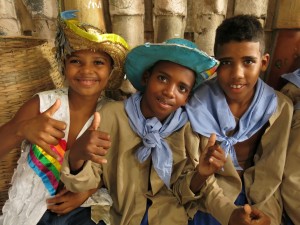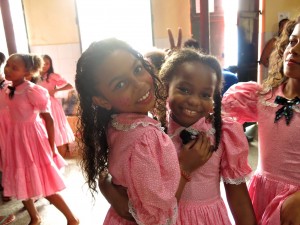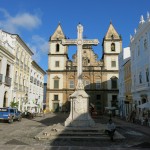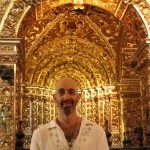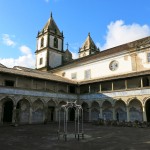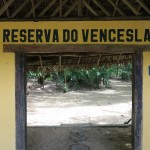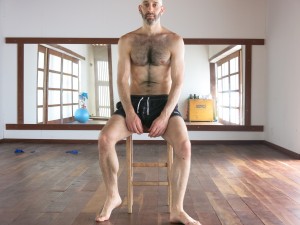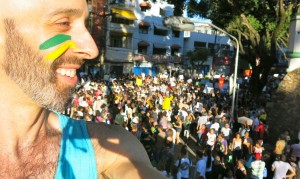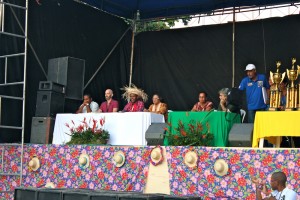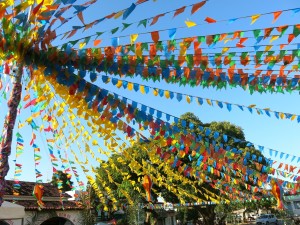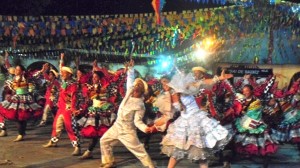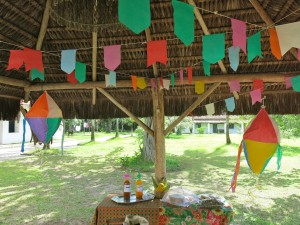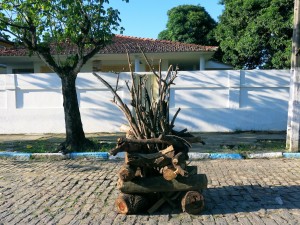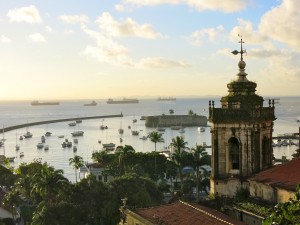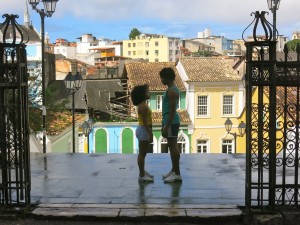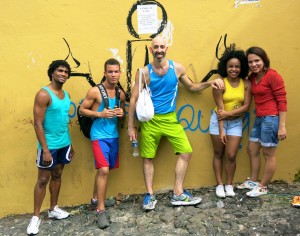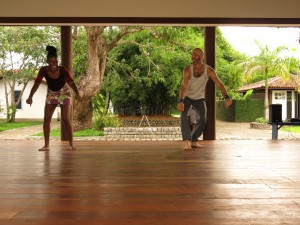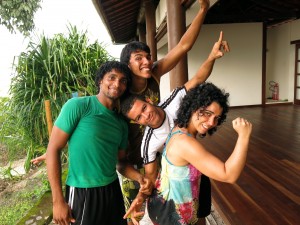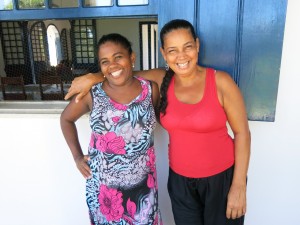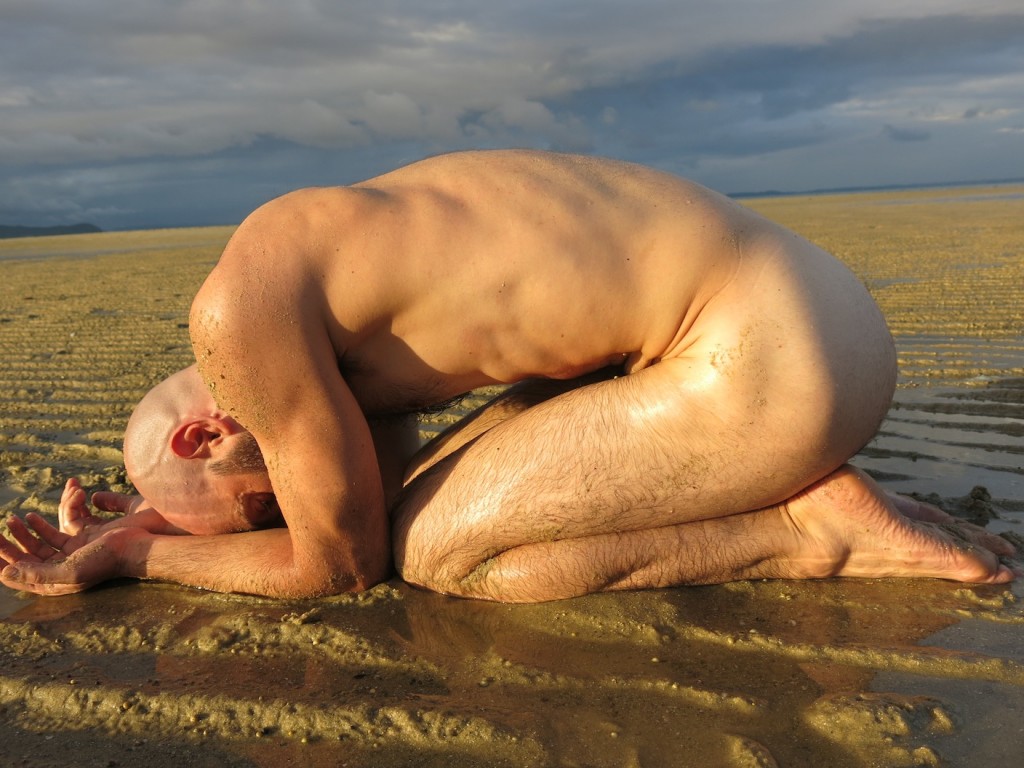BRAZIL JOURNAL
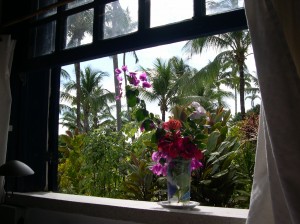 Welcome to the Journal. Entries are posted chronologically. Scroll to read the most recent.
Welcome to the Journal. Entries are posted chronologically. Scroll to read the most recent.
MAY 1, 2013–In a few days I will be leaving for Bahia thanks to the generous support of the Sacatar Foundation, which has invited me. Ten years ago I had the great fortune to be in residence and I cannot believe that lightning will actually strike twice. The INSTITUTO SACATAR operates a residency program for creative individuals in all disciplines at its estate on the Island of Itaparica in the Bay of All Saints, across from the city of Salvador, Bahia, Brazil. The purpose of the Institute is:
• To provide artists a place to live and create
• To generate opportunities for artists to interact and collaborate with the local and regional community
• To enhance the visibility and cultural impact of the host city and nation
• To encourage art that returns us to where art began — to a wordless silence before all of creation
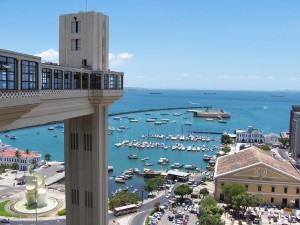 Ten years ago I had the indelible experience of waking up my first morning to this view from my bedroom. Ten years ago I had the incredible experience of meeting numerous people and making wonderful friends from the island of Itaparica and the bustling metropolis of Salavador, a city of over 2.68 million (photo of Pelourinho). Ten years ago I had the incredible experience of choreographing a dance, Renascimento, (Rebirth) for thirty dancers from the community, ranging from a boy ten years old, to professionals, to a woman in her 60s.
Ten years ago I had the indelible experience of waking up my first morning to this view from my bedroom. Ten years ago I had the incredible experience of meeting numerous people and making wonderful friends from the island of Itaparica and the bustling metropolis of Salavador, a city of over 2.68 million (photo of Pelourinho). Ten years ago I had the incredible experience of choreographing a dance, Renascimento, (Rebirth) for thirty dancers from the community, ranging from a boy ten years old, to professionals, to a woman in her 60s.
In a few days I will be back on Bahian soil. What incredible experiences await this time?
MAY 8, Itaparica. Quarta-Feira. Wednesday, literally the fourth day of the week.
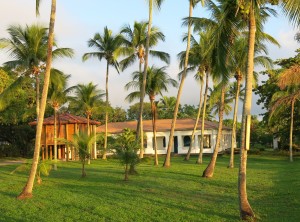 Arriving in Salvador Monday morning was an immediate return to summer. A shirt comes off. Sunblock goes on. Within minutes of being outside. While it is the rainy season, and rain will most definitely come, so far it has been gloriously blue-skied and quente (hot).
Arriving in Salvador Monday morning was an immediate return to summer. A shirt comes off. Sunblock goes on. Within minutes of being outside. While it is the rainy season, and rain will most definitely come, so far it has been gloriously blue-skied and quente (hot).
The journey from Salvador to Itaparica is not far in distance, 21km, but enormous in contrast. The “ferry-boat” crawls across the Baia de Todos os Santos (The Bay of All Saints), preparing one for the slower, easier way of life here, away from the chaos of the large, frenetic city. In fact, a plan to build a bridge is on the tip of everyone’s tongue, the politicians promoting the benefits, the community fiercely opposed. There are six Fellows here: a visual artist from Cachoeira (a city in the state of Minas Gerais, which borders Bahia to the south); a poet from New Zealand who traveled 36 hours to get to Itaparica; a photographer from Lithuania; a composer from Nigeria; and a writer from Zimbabwe.
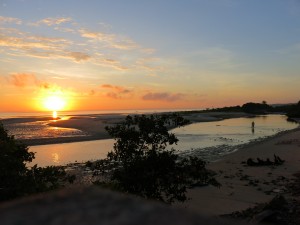 Tuesday morning, I am up at 5:45, in time to see the sun’s rise over low tide (maré baixa). It is common to see men collecting crabs. One should click on this photo to see the true magnificence! This is taken from outside the dance studio, spacious and floored with dark wood, which opens up right onto the Bay. Imagine! Paradise twenty-four hours a day. My room is in this building. When sleeping, the waves of high tide coupled with the ocean’s breeze makes me think I’m in a boat.
Tuesday morning, I am up at 5:45, in time to see the sun’s rise over low tide (maré baixa). It is common to see men collecting crabs. One should click on this photo to see the true magnificence! This is taken from outside the dance studio, spacious and floored with dark wood, which opens up right onto the Bay. Imagine! Paradise twenty-four hours a day. My room is in this building. When sleeping, the waves of high tide coupled with the ocean’s breeze makes me think I’m in a boat.
Visiting artists from Belo Horizonte, the capital of Minas Gerais, took lunch with us and spent the day in Itaparica. After lunch the tide was high (2.3 m). The first swim in the Bay, the water warm as soup, the beach pure sand. We walked for hours around Itaparica, acquainting ourselves with the geography and services. We met many people: the South African woman who makes chocolate with cocoa growing in her backyard. She demonstrated how it is made, splitting open the cocoa on her ledge. We sucked the slimy beans. And Serge, the Frenchman who runs the pousada (hotel), remembered me! He has kept a leaping photograph from these many years ago. When asked if that was him when he was younger, he has replied, “No, that is my brother.”
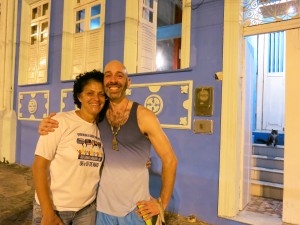 Finally, in the evening I reunited with Omara, close friend and collaborator, who runs the Oficina de Artes. Tears flowed. I was overcome with joy to be with her again. Already we began planning for the residency. I also saw Claudia, a student of Omara’s, now 33, who had danced in the project in 2003.
Finally, in the evening I reunited with Omara, close friend and collaborator, who runs the Oficina de Artes. Tears flowed. I was overcome with joy to be with her again. Already we began planning for the residency. I also saw Claudia, a student of Omara’s, now 33, who had danced in the project in 2003.
This first week is built around acclimation and orientation. There are numerous aspects to learn about: the Bahian culture, the Portuguese language, the culture of the residency, the context of where we are! Coming from New York the contrast could not be more vivid. We will tour Salvador tomorrow and the ilha (island) of Itaparica on Friday.
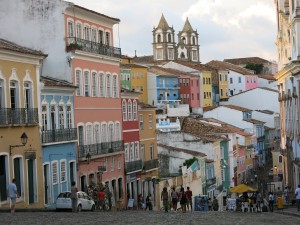 MAY 14, Terca-Feira, Tuesday. The Internet is fickle here, like the rains. Suddenly there is an opening and it pours with intensity. Last week’s tours of Salvador and the island of Itaparica were glorious and thankfully dry.
MAY 14, Terca-Feira, Tuesday. The Internet is fickle here, like the rains. Suddenly there is an opening and it pours with intensity. Last week’s tours of Salvador and the island of Itaparica were glorious and thankfully dry.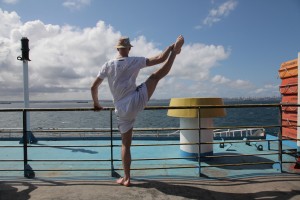
Built on a high cliff overlooking the Bay, Salvador was the first colonial capital of Brazil and became both its main port and an important center of the sugar industry. It was, horribly, also a center of the slave trade. I am currently reading To Be A Slave In Brazil, a book in the Institute’s library. More on this… The city is very spread out, not only in length. Due to the geography the city was divided into upper and lower regions with Cidade Alta (high city) about 280 feet above Cidade Baxia. Historically, most of the population lived in the heights, which housed the administrative buildings; the lower city was the financial center, port and market.
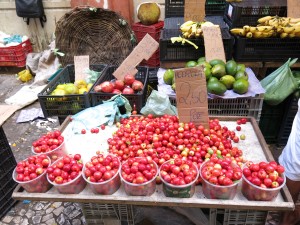 In 1873 Elevador Lacerda was built, the first elevator installed in Brazil. With only one of four elevators working the line, and wait, was long. Still longer, and strenuous, would be to climb by foot. There is an unspoken policy here whereby older adults and those with babies proceed to the front of the line. Waiting is part of life here; there are times there is nothing one can do about it. For example, we had intended to take the lancha, a small wooden boat, from Mar Grande, but the line was hours long. We drove to Bom Despacho to catch the ferry; the front of the boat was a perfect place to do a little stretching!
In 1873 Elevador Lacerda was built, the first elevator installed in Brazil. With only one of four elevators working the line, and wait, was long. Still longer, and strenuous, would be to climb by foot. There is an unspoken policy here whereby older adults and those with babies proceed to the front of the line. Waiting is part of life here; there are times there is nothing one can do about it. For example, we had intended to take the lancha, a small wooden boat, from Mar Grande, but the line was hours long. We drove to Bom Despacho to catch the ferry; the front of the boat was a perfect place to do a little stretching!
We explored the lower city and the colorful historic center of Pelourinho, with its colonial Portuguese influence. Thomé de Sousa, the first Governor of Brazil, established Salvador in 1549. One of the oldest cities in the Americas, it is known for its food, music, architecture and for its African influence, making it a center of Afro-Brazilian culture.
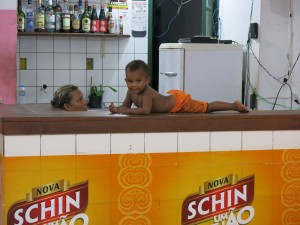 The island of Itaparica is big and takes time to cover, literally and otherwise. I will post photos from these varied places. For now, a few images from Salvador.
The island of Itaparica is big and takes time to cover, literally and otherwise. I will post photos from these varied places. For now, a few images from Salvador.
And what have I been doing? Sketching site-specific dance videos; creating new movement in the studio; preparing for a presentation in Salvador at the Museu de Arte Moderna da Bahia (MAM) on Thursday, and planning different ways to interact with the Itaparican and Salvadorian communities. I am making daily contacts with schools, artists, and organizations for the collaborative work projects ahead.
MAY 17, SEXTA-FEIRA, some photos from the past week! These thumbnails only show part of the story, so do click on them to see the full view in high resolution.
The exterior of The Church of São Francisco of Salvador.
Standing inside the interior where all surfaces are covered by gold!
The convent of São Francisco is also a sight with its enormous panels of blue-white tile (azulejo). The two-story cloisters, finished around 1752, were decorated with these tiles (made in Lisbon) of moralistic allegories based on words by the Roman poet Horace.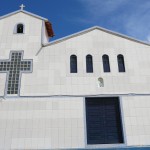
In Porto Santo we went to the Reserva do Venceslau, where the hermit Venceslau Monteiro was miraculously healed of blindness, and where he lived. I waded into the water (the pool of miracles) hoping some of the magic might extend my dancing feet by a few years! In Manguinhos this lovely church, Nosso Senhora Do Amparo and a very curious relic. Take a close look at this tree trunk. It is the ruin of a whale oven! 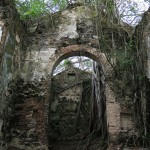 The ruins of the Church of Our Lord of Vera Cruz, one of the oldest churches in Brazil, was founded by the Jesuits in 1560.
The ruins of the Church of Our Lord of Vera Cruz, one of the oldest churches in Brazil, was founded by the Jesuits in 1560. 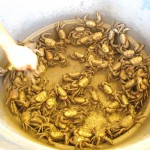 A tub of live crabs in Mar Grande, the lively port town where the lanchas (wooden boats) leave for Salvador.
A tub of live crabs in Mar Grande, the lively port town where the lanchas (wooden boats) leave for Salvador.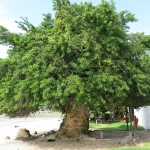
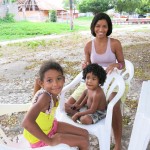 Beautiful children in Cacha Pregos, the other end of the island from Itaparica.
Beautiful children in Cacha Pregos, the other end of the island from Itaparica.
MAY 26, DOMINGO (Sunday)–Today was a fantastic day. After breakfast, biked with two of the other fellows to Atlantico, the largest supermarket in this part of Itaparica.
The trip is not far, about 10 minutes by bike, along cobblestones, the main artery into Itaparica. People were outside lining the streets at various places. “Oi, tudo bem? E ai?…Boa…ola…” Everyone always responds. You just have to talk like a local! It was our first time at the store. Basically they had everything that the smaller Mercado de Alto has right in the closest square, only more of everything. Not more varieties, just more quantity. 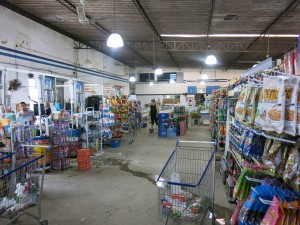
It is interesting. One of the fellows made the comment that Brazil does not export that much, like other countries. The products are basic. I was unable to find a jar or container of nuts except for small bags near the check-out of coated peanuts. Even cashews, which are expensive, are not so common. They are wrapped in a styrofoam shallow tray hand wrapped with plastic. The cashews, which are cultivated here, are mostly exported. Did you know that each cashew comes from a single caju fruit?
 While caju is not in season now, I did take some photos the last time I was in Brazil. There is a tree on the property. This single fruit generates a single cashew! (We understand why they are so expensive.) And it was common to see people selling the fruit, which makes great juice. The cashews I bought are not salted, rather gummy, and charred, as if roasted. Happy to find those. I never travel anywhere, least of all on the NYC subway, without my emergency nuts!
While caju is not in season now, I did take some photos the last time I was in Brazil. There is a tree on the property. This single fruit generates a single cashew! (We understand why they are so expensive.) And it was common to see people selling the fruit, which makes great juice. The cashews I bought are not salted, rather gummy, and charred, as if roasted. Happy to find those. I never travel anywhere, least of all on the NYC subway, without my emergency nuts! 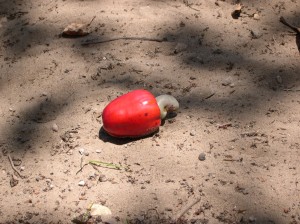
No chocolate bars of any kind at the supermarket, although candy can always be found. Two kinds of cheese (very thin slices on the same styrofoam tray), mozzarella and a yellow mild cheese. A good selection of wine and liquor. Cachaca, which we’ve been enjoying, the primary ingredient of Brazil’s famous capirinha, costs only 5.50 Reais here (about $2.75), for the bottle. In NY, with typically one brand to choose from, it would be upwards of $25. It is the alcohol made from sugar cane, akin to a rum.
Inside the market, in started to pour! Rain was coming in through the ceiling. Everyone in it was waiting to exit. Then they closed the garage-type doors and turned off the lights. Turned out the store was closing at noon! So we bought some beers and waited for the rain to stop, which it did eventually. 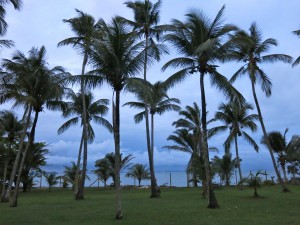
This afternoon, after making shakshouka for lunch, I went to visit Omara at her place. We had a coffee and then went to a local stadium to watch the Itaparica team, in second place, play the number one team. Yes, futbol! This is a league of teens, under 16. There was a band playing in the stadium and a man selling peanuts in the shell. I bought a bag’s worth for a quarter. The game, and the crowd, was spirited. High tide was about 5pm today 2 (2.5 meters) and one of the Fellows and I took two two kayaks out into the Bay for an excursion along the coast. Terrific to kayak during the sunset hours and during high tide. And then it was impossible not to go in for a swim!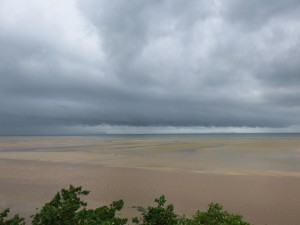
All in all a lovely day off. Biking, kayaking, swimming, futbol, and now we will go to Gringo’s for dinner! Yes, Gringo’s for the gringos. Gringo=foreigner, stranger. It is not derogatory to refer to someone as one, but of course context is everything. I am too dark in Bahia to pass as Brazilian but American is not the first thing people think when meeting me (then again, in the States too, this is true). Italian, I mostly hear. My Portuguese is flowing happily at this point. I am able to carry on conversations with anyone, mais o menas (more or less). But really more. More about that, and the work work I’m doing here too, to come. Bahia, you are so beautiful!
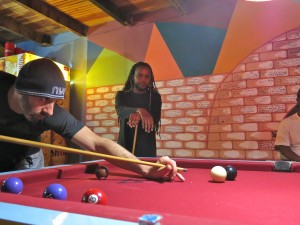 SEGUNDA-FEIRA (Monday), 27, Memorial Day in the states. Here, another day. We got caught in the rain after dinner and had to stick around for a good while. No cabs to call for here on this part of the island, on a Sunday night! We made it home just before the downpour began again. It rained hard all night and through half the day today. And then it beautifully cleared.
SEGUNDA-FEIRA (Monday), 27, Memorial Day in the states. Here, another day. We got caught in the rain after dinner and had to stick around for a good while. No cabs to call for here on this part of the island, on a Sunday night! We made it home just before the downpour began again. It rained hard all night and through half the day today. And then it beautifully cleared.
The rain allowed me a chance to actually stay indoors and edit! The proposed project here has centered around creating a body of videodance work, reflective of the natural and man-made landscapes (physical, cultural, musical) in Bahia. I’ve been shooting daily. Several projects have sprung up at once. Today I edited a project I believe will be perceived as quite fun!
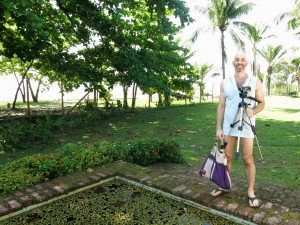 There are still several films, some fully edited, others in various stages of development, incubated at the Djerassi Resident Artists Program that Stefanos (Stefanos Milkidis, my to-be husband, and Company visual and video collaborator) and I attended this past January. No Trespassing has been entered in various film festivals. Sisyphus had its NY premiere at the Abrons Center in April.
There are still several films, some fully edited, others in various stages of development, incubated at the Djerassi Resident Artists Program that Stefanos (Stefanos Milkidis, my to-be husband, and Company visual and video collaborator) and I attended this past January. No Trespassing has been entered in various film festivals. Sisyphus had its NY premiere at the Abrons Center in April.
Here I have been creating work in various locales, but all here at Sacatar. This will change as I go out into the wider world soon.
Today’s morning clouds cast great shadows. Bands of light across the low tide Bay floor. Sun streaming into the studio, shadows and sun. Developing new material inspired by Fela’s music, which I’ve been listening to thanks to one of the Fellows, a singer from Nigeria. Fela Kuti, NIgerian musician, composer, inventor of Afrobeat music. The music gets me going! Here’s a self-portrait after the morning work-out. To Omara’s studio to work with a select group of students, developing choreography for a few projects. 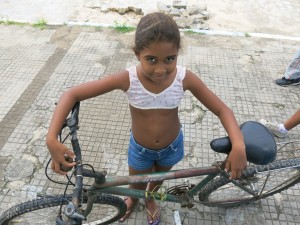 On my way, biking over, a voice calls to me, Lorrana. A few weeks ago she sat next to me on a doorstep and we became friends. Lorrana is eight. I took photos of her that first day, with her Minnie Mouse dress. Today she was no less cute and I asked her if she wanted to help me with the dance class. She shrugged and said, yes, why not? She helped open up the windows (the white shutters and white wooden windows), move a table, unpack my bag, untangle and hook up the stereo speakers, and she learned how to operate the still camera. Very curious and smart, I began preparing by teaching her sixteen counts of arm movements.
On my way, biking over, a voice calls to me, Lorrana. A few weeks ago she sat next to me on a doorstep and we became friends. Lorrana is eight. I took photos of her that first day, with her Minnie Mouse dress. Today she was no less cute and I asked her if she wanted to help me with the dance class. She shrugged and said, yes, why not? She helped open up the windows (the white shutters and white wooden windows), move a table, unpack my bag, untangle and hook up the stereo speakers, and she learned how to operate the still camera. Very curious and smart, I began preparing by teaching her sixteen counts of arm movements. 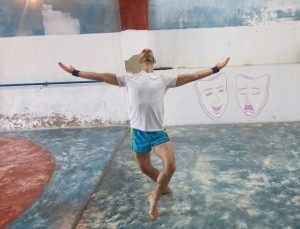 We stood frente a frente (facing each other, front to front) and she mirrored the movements, until she had learned them. Completely unprompted, Loranna proceeded to take photos of me while I warmed up. Many! And they are all good. This is one of hers. I would move and she would click. While I can communicate with her in Portuguese, she understood what was happening, independent of language. She stayed for the rehearsal and danced at the end.
We stood frente a frente (facing each other, front to front) and she mirrored the movements, until she had learned them. Completely unprompted, Loranna proceeded to take photos of me while I warmed up. Many! And they are all good. This is one of hers. I would move and she would click. While I can communicate with her in Portuguese, she understood what was happening, independent of language. She stayed for the rehearsal and danced at the end.
MAY 29, QUARTA-FEIRA (Wednesday)
 The day started with a swim! High tide was at 7am, and the sun was out, so there was no second thought. After breakfast I went to the Colegio Sao Luis, a private school, for the first time. The director, Virginia, was enthusiastic and lovely. I also met with the physical education teacher, Marcos. I taught his class of 27 students, equal number boys and girls, ages 15-18. The schools is on multiple levels, around a large courtyard. The school used to be a convent. There are sisters around, but they do not teach; they take care of the property.
The day started with a swim! High tide was at 7am, and the sun was out, so there was no second thought. After breakfast I went to the Colegio Sao Luis, a private school, for the first time. The director, Virginia, was enthusiastic and lovely. I also met with the physical education teacher, Marcos. I taught his class of 27 students, equal number boys and girls, ages 15-18. The schools is on multiple levels, around a large courtyard. The school used to be a convent. There are sisters around, but they do not teach; they take care of the property. 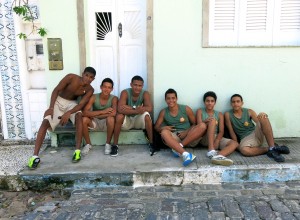 The school is young children though high school. The class, none of the students had danced before here too, did great, focused and eager and capable. After the class I took this photo of some of the boys who were hanging out across the gate of the entrance to the school. They said they had a thirty-minute break. I asked them their names and their ages. From left to right: Dilson (18), Hamilton (16), Meurillo (21), Simeone (16), Brendo (16), Silas (15). The school would like me to teach the 8th and 9th grades and also the younger students. I would like to meet the other high school students too. There are 90 total.
The school is young children though high school. The class, none of the students had danced before here too, did great, focused and eager and capable. After the class I took this photo of some of the boys who were hanging out across the gate of the entrance to the school. They said they had a thirty-minute break. I asked them their names and their ages. From left to right: Dilson (18), Hamilton (16), Meurillo (21), Simeone (16), Brendo (16), Silas (15). The school would like me to teach the 8th and 9th grades and also the younger students. I would like to meet the other high school students too. There are 90 total. 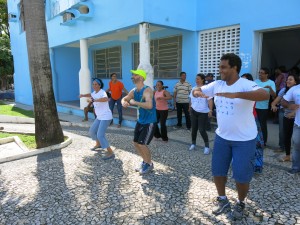 So…now I have to plan what is realistic in the amount of time we have. My schedule has become quite full here. Three and a half weeks in. How quickly the time has passed and will. After class I was on my way to the Prefeitura (Town Hall) to find Omara when I heard her call my name in the street. Today was some special day of “challenge” and she was corralling people to join in a dance in front of the building. Suddenly I am dancing on the street with Omara and her brother, the vice-mayor of Itaparica. Back at the Quinta (house) we had a few former fellows visiting
So…now I have to plan what is realistic in the amount of time we have. My schedule has become quite full here. Three and a half weeks in. How quickly the time has passed and will. After class I was on my way to the Prefeitura (Town Hall) to find Omara when I heard her call my name in the street. Today was some special day of “challenge” and she was corralling people to join in a dance in front of the building. Suddenly I am dancing on the street with Omara and her brother, the vice-mayor of Itaparica. Back at the Quinta (house) we had a few former fellows visiting  (this happens with some frequency) for lunch. I was drawn to the low tide and the strong sun and prepared for a shoot outside. One of the projects I’m working on has been shot on the beach and the editing these past few days has revealed the need for a few additional shots. This was 1pm sun, but at this point I can shellac myself with 15 SPF and be good for the remainder of the day. Have built up a tolerance to the sun. This was a good shoot. After, read in one of the hammocks on the veranda an autobiography of Caetano Veloso, one of Brazil’s most legendary singer/composers.
(this happens with some frequency) for lunch. I was drawn to the low tide and the strong sun and prepared for a shoot outside. One of the projects I’m working on has been shot on the beach and the editing these past few days has revealed the need for a few additional shots. This was 1pm sun, but at this point I can shellac myself with 15 SPF and be good for the remainder of the day. Have built up a tolerance to the sun. This was a good shoot. After, read in one of the hammocks on the veranda an autobiography of Caetano Veloso, one of Brazil’s most legendary singer/composers. 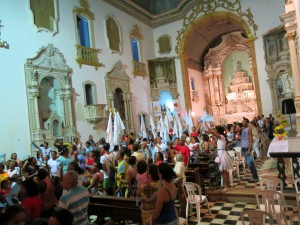 After dinner went into town to watch a religious ceremony. Tomorrow is a holiday, Corpus Christi. There is no school and the staff will not be working here at the Institute. The large church was open for the first time and streamers crisscrossed the square. Finally the crowd moved down the narrow street, the children in white, dressed as angels, with candles, and a float with a shrouded figure with a crown. Everyone was singing, loudly. A sight and sound to take in.
After dinner went into town to watch a religious ceremony. Tomorrow is a holiday, Corpus Christi. There is no school and the staff will not be working here at the Institute. The large church was open for the first time and streamers crisscrossed the square. Finally the crowd moved down the narrow street, the children in white, dressed as angels, with candles, and a float with a shrouded figure with a crown. Everyone was singing, loudly. A sight and sound to take in.
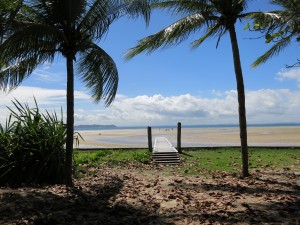 JUNE 1, SABADO (Saturday)
JUNE 1, SABADO (Saturday)
Two amazing days, these past. Thursday, the holiday, was a beautiful morning. Its charms irrestible. High tide and breakfast both at 8. I threw out the idea to Magnolia, one of the Fellows, to go kayaking. She said give me five minutes to think and I said I was going to shave and put my eyes in and then we would touch base. The day, its warmth, cloudless sky, brilliant sun, enticing high tide, lured. We had intended to go a bit along the coastline, to a town round the bend. And we set off, with nothing on but bathing suits and sunblock. We realized we’d have to go for a very brief time, or we’d have difficulty getting back due to low tide. By the time we left, after 10, the tide was receding quickly. We could always drag the kayaks along the beach. And we could get fairly close to the property if far out in the deep. 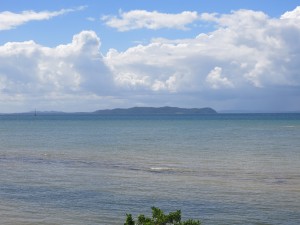 Within minutes the idea of paddling to Ilha dos Frades, the large mountainous island across the Bay, seduced. We had no idea how long it would take but decided to have an adventure. Blissfully ignorant, of the distance, of what we’d encounter there, we kept on.
Within minutes the idea of paddling to Ilha dos Frades, the large mountainous island across the Bay, seduced. We had no idea how long it would take but decided to have an adventure. Blissfully ignorant, of the distance, of what we’d encounter there, we kept on.
About an hour and a half or so in, Magnolia spotted movement, something jumping out of the water. I didn’t see anything, and then I did, several dark objects bobbing up and down. No, wait, fins! We had entered a pod of dolphins. Or were they? At this point we started to question our intelligence as we were getting closer to what appeared to be dozens of large finned animals diving in front and to the side of us. 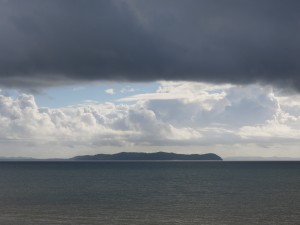 Fortunately, a small yacht happened to be heading toward us as this moment. We were uncertain whether to retreat. What if they are sharks? I raised my hand to wave hello to the man steering the yacht, with a thumbs up, and as he passed he slowed down, turned around and came back toward us. Had we inadvertently signaled distress? I did not know the word for dolphin, so I asked if the “big fish” were dangerous. Imagine, two gringos in the sea lane, directly in the middle of the Bay asking about big fish! He said golfinho, which we understood to be dolphin. And so he, his wife and small son went on their way and we continued on ours. What magic. Scores of dolphins. Two leapt from the water, arced into the air, and back into the water, following one another in identical form. Another shot up, did a back flip fully out of the water, and submerged.
Fortunately, a small yacht happened to be heading toward us as this moment. We were uncertain whether to retreat. What if they are sharks? I raised my hand to wave hello to the man steering the yacht, with a thumbs up, and as he passed he slowed down, turned around and came back toward us. Had we inadvertently signaled distress? I did not know the word for dolphin, so I asked if the “big fish” were dangerous. Imagine, two gringos in the sea lane, directly in the middle of the Bay asking about big fish! He said golfinho, which we understood to be dolphin. And so he, his wife and small son went on their way and we continued on ours. What magic. Scores of dolphins. Two leapt from the water, arced into the air, and back into the water, following one another in identical form. Another shot up, did a back flip fully out of the water, and submerged. 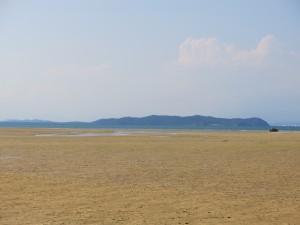 Clusters of four, five fins at a time surfaced and disappeared. Now they were behind us and on all sides. Of course we didn’t have cameras with us; we didn’t even have water, food, or shoes. Between us we had 18 reais (about nine dollars). A hand towel, fortunately, covered my shoulders and neck. Magnolia had a scarf which she made into a turban. What a sight we were.
Clusters of four, five fins at a time surfaced and disappeared. Now they were behind us and on all sides. Of course we didn’t have cameras with us; we didn’t even have water, food, or shoes. Between us we had 18 reais (about nine dollars). A hand towel, fortunately, covered my shoulders and neck. Magnolia had a scarf which she made into a turban. What a sight we were.
After the deception of kayaking in place, we eventually saw the island zoom larger. But it was a distance. Google maps doesn’t compute the distance for crossing the Bay, only to drive there, which would take three and a half hours. It looks to be slightly more than ten miles.  Close to three hours later we beached onto the white sand, an inlet amid dense vegetation. A few small wooden boats, a larger lancha, umbrellas on the sand, and some people playing futbol, relaxing on the beach. Within five minutes of our arrival, we were given beers by a friendly man, who was with a large cooler and a few friends. They marveled that we came from Itaparica. None of them could believe that. We arrived at 1 and spent the entire day with this group of ten. Their kindness epitomizes the open, easy-going and overwhelmingly generous spirit of the Bahian people.
Close to three hours later we beached onto the white sand, an inlet amid dense vegetation. A few small wooden boats, a larger lancha, umbrellas on the sand, and some people playing futbol, relaxing on the beach. Within five minutes of our arrival, we were given beers by a friendly man, who was with a large cooler and a few friends. They marveled that we came from Itaparica. None of them could believe that. We arrived at 1 and spent the entire day with this group of ten. Their kindness epitomizes the open, easy-going and overwhelmingly generous spirit of the Bahian people. 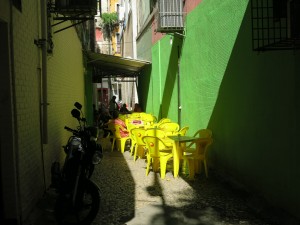 We were included in lunch (off the beach in this little area where a man cooked a fish and rents out little cabins with not even a bed in them!), endless bottles of cerveja, and best of all, a ride back to Itaparica! At sunset, we glided across the Bay, kayaks inside the small blue boat, with the most wonderful, lovely, new friends. One of them spoke English and took photos. Hope to get some! It was a magical day. The island exquisite and remote. No tourists here. Shaped as a fifteen tip star, there is a beach between each of the tips. We were at Ponta de Nossa Senhora de Guadalupe, which has a stunning church high in the hills. It was dark and the tide was still low when were were dropped off, about fifteen minutes from the Institute.
We were included in lunch (off the beach in this little area where a man cooked a fish and rents out little cabins with not even a bed in them!), endless bottles of cerveja, and best of all, a ride back to Itaparica! At sunset, we glided across the Bay, kayaks inside the small blue boat, with the most wonderful, lovely, new friends. One of them spoke English and took photos. Hope to get some! It was a magical day. The island exquisite and remote. No tourists here. Shaped as a fifteen tip star, there is a beach between each of the tips. We were at Ponta de Nossa Senhora de Guadalupe, which has a stunning church high in the hills. It was dark and the tide was still low when were were dropped off, about fifteen minutes from the Institute. 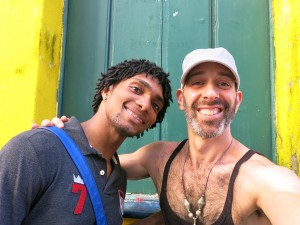 We dragged the kayaks home through the shallow water. These are all different photos from the past month that show Ilha dos Frades from the property here. The view is always different. Even within the same day. In fact, so many countless times within the same day. And each day is its own mystifying, miraculous creation.
We dragged the kayaks home through the shallow water. These are all different photos from the past month that show Ilha dos Frades from the property here. The view is always different. Even within the same day. In fact, so many countless times within the same day. And each day is its own mystifying, miraculous creation.
Friday I went in to Salvador for a few meetings and to buy some needed additional technology (shooting daily is eating up the gigabytes!). I met Leonardo, a professional dancer whose name I had been given from the director of VivaDanca International Festival, with whom I had met a few weeks ago. We have some mutual dance friends in common! He is interested in working with me here on the island. Word is spreading and I have also reached out to other dancers that have come my way through word of mouth. Planning to teach a class to the professional community to have the opportunity to meet the dancers here.
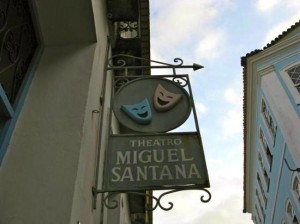 Later in the day, a truly fantastic experience with the amazing Balé Folclorico da Bahia! I had been invited to attend a rehearsal at the company’s studios, right in the heart of Pelourinho. They have their own theater, Teatro Miguel Santana, and perform nightly. This is an internationally renown company with an incredible history, which can be read about HERE on their site. The repertory is based on Bahian folkloric dances of African origin and includes slave dances, capoeira, samba, and those that celebrate Carnival. The company presents “the region’s most important cultural manifestations under a contemporary theatrical vision that reflects its popular origins.”
Later in the day, a truly fantastic experience with the amazing Balé Folclorico da Bahia! I had been invited to attend a rehearsal at the company’s studios, right in the heart of Pelourinho. They have their own theater, Teatro Miguel Santana, and perform nightly. This is an internationally renown company with an incredible history, which can be read about HERE on their site. The repertory is based on Bahian folkloric dances of African origin and includes slave dances, capoeira, samba, and those that celebrate Carnival. The company presents “the region’s most important cultural manifestations under a contemporary theatrical vision that reflects its popular origins.” 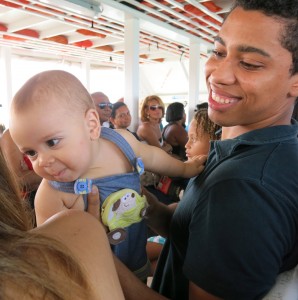 When I arrived I was able to see the end of class–the technique varies on the day–an Afro-Brazilian one with everyone in consistent rotation around a circle, following the teacher. Most were wearing white, the men, mostly without shirts. I have never seen dancers more gorgeous.
When I arrived I was able to see the end of class–the technique varies on the day–an Afro-Brazilian one with everyone in consistent rotation around a circle, following the teacher. Most were wearing white, the men, mostly without shirts. I have never seen dancers more gorgeous. 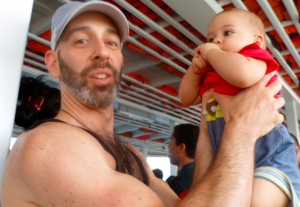 I wanted to get off the bench and join the end of class immediately. Looking forward to studying with the company. I had been told even before meeting that the studio could serve as “my second home” while here. The generosity of Bahia. The company, ten men and seven women, plus musicians and singers, rehearsed a new work that will tour internationally this September (including New York). I sat next to Zebrinha, the artistic director, as the dancers, all stunning, worked through a relentlessly demanding and rhythmic piece. It was as strong an experience as the first time I had seen the Alvin Ailey company as a boy. After the rehearsal the company director, Walson, introduced me to the dancers. Zebrinha invited me to teach the company next week. How great!
I wanted to get off the bench and join the end of class immediately. Looking forward to studying with the company. I had been told even before meeting that the studio could serve as “my second home” while here. The generosity of Bahia. The company, ten men and seven women, plus musicians and singers, rehearsed a new work that will tour internationally this September (including New York). I sat next to Zebrinha, the artistic director, as the dancers, all stunning, worked through a relentlessly demanding and rhythmic piece. It was as strong an experience as the first time I had seen the Alvin Ailey company as a boy. After the rehearsal the company director, Walson, introduced me to the dancers. Zebrinha invited me to teach the company next week. How great!
Also great was the beautiful baby who was sitting behind me on the lancha. He was reaching toward me and his father said I could hold him. Bernard, eight months old!
JUNE 9, DOMINGO, Sunday
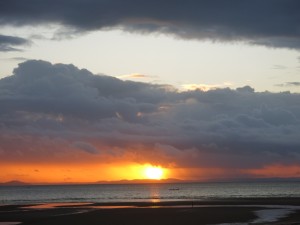 Day 35. The thirty-fifth day waking up in Brazil, on this beautiful island. Days go by slowly but weeks fly. Which is a remarkable place and time to be. The length and variations of each day is felt. The weather can change in an instant. The winds pick up. A sudden battering of rain, the sky grey, no trace of the other islands or Salvador’s skyline, and then you take a nap (perhaps) and awaken to a blue and golden day. Or there isn’t even time for a nap. So rapidly it changes. Where has the time gone? Most happily to things I want to be doing: exploring nature, creating, meeting people, seeing new places. I had written about the most remarkable excursion to the Ilha dos Frades by kayak with my partner-in-crime Magnolia.
Day 35. The thirty-fifth day waking up in Brazil, on this beautiful island. Days go by slowly but weeks fly. Which is a remarkable place and time to be. The length and variations of each day is felt. The weather can change in an instant. The winds pick up. A sudden battering of rain, the sky grey, no trace of the other islands or Salvador’s skyline, and then you take a nap (perhaps) and awaken to a blue and golden day. Or there isn’t even time for a nap. So rapidly it changes. Where has the time gone? Most happily to things I want to be doing: exploring nature, creating, meeting people, seeing new places. I had written about the most remarkable excursion to the Ilha dos Frades by kayak with my partner-in-crime Magnolia. 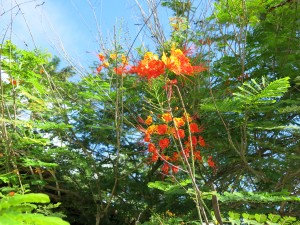 I have just read her accounting and it is definitely worth the read. She is after all a writer! And a marvelous one. Her description captures the magic of the day with great detail and humor. The title of her blog about this is “Thursday was this ridiculous” and you can read it HERE. I didn’t realize I had such a winning role! I was most happy to read her witty and informative travelogue, “Learn to Lean Back in Salvador,” which was posted on The Volcanic, an online publication from Auckland. I encourage you to read this insightful piece too HERE.
I have just read her accounting and it is definitely worth the read. She is after all a writer! And a marvelous one. Her description captures the magic of the day with great detail and humor. The title of her blog about this is “Thursday was this ridiculous” and you can read it HERE. I didn’t realize I had such a winning role! I was most happy to read her witty and informative travelogue, “Learn to Lean Back in Salvador,” which was posted on The Volcanic, an online publication from Auckland. I encourage you to read this insightful piece too HERE.
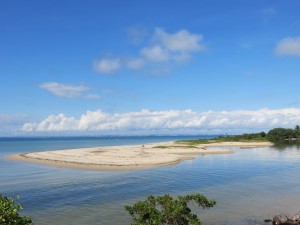 In this piece Magnolia writes about candomblé, a very powerful Afro-Brazilian religion. It was born from the Africans who were taken from their homeland and transplanted to Brazil during the slave trade. We have all been invited to at least one candomblé service. The name translates to dance in honor of the gods. I went a few weeks ago, late at night. The setting was otherworldly. A cab took us off the paved roads and down a dirt one where a bonfire was lit outside a huge hall full of people, both participating and watching from all sides. The live percussion, singing and highly stylized dance are vibrant and instrumental elements of this ritual. We left before midnight and heard the service would continue until 3 or 4 in the morning.
In this piece Magnolia writes about candomblé, a very powerful Afro-Brazilian religion. It was born from the Africans who were taken from their homeland and transplanted to Brazil during the slave trade. We have all been invited to at least one candomblé service. The name translates to dance in honor of the gods. I went a few weeks ago, late at night. The setting was otherworldly. A cab took us off the paved roads and down a dirt one where a bonfire was lit outside a huge hall full of people, both participating and watching from all sides. The live percussion, singing and highly stylized dance are vibrant and instrumental elements of this ritual. We left before midnight and heard the service would continue until 3 or 4 in the morning. 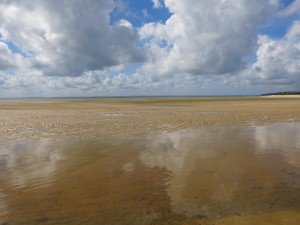 The religion is based in the soul of the natural environment. Orixas are ancestors who have been deified, a link between the spiritual and human worlds. Candomblé practitioners believe that every person has their own individual orixa which controls his or her destiny and acts as a protector. Each orixa represents a certain force in nature and is associated with certain foods, colors, animals and days of the week. During the service choreographed dances are performed in order to become possessed of each ancestor spirit. From the earliest days of the slave trade, many Christian slave owners and church leaders felt it was important to convert the enslaved Africans.
The religion is based in the soul of the natural environment. Orixas are ancestors who have been deified, a link between the spiritual and human worlds. Candomblé practitioners believe that every person has their own individual orixa which controls his or her destiny and acts as a protector. Each orixa represents a certain force in nature and is associated with certain foods, colors, animals and days of the week. During the service choreographed dances are performed in order to become possessed of each ancestor spirit. From the earliest days of the slave trade, many Christian slave owners and church leaders felt it was important to convert the enslaved Africans. 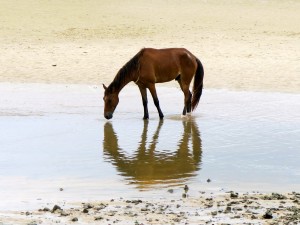 This was in order to fulfill their religious obligations but also in the hope of making the enslaved more submissive. Although the Church succeeded in many cases, not all Africans converted. Many outwardly practiced Christianity but secretly prayed to their own god, gods or ancestor spirits. In Brazil, where Catholicism was popular, adherents of candomblé saw in the worship of saints a similarity with their own religion. Candomblé practitioners often hid the sacred symbols of their deities inside their corresponding Catholic saints. Candomblé was condemned by the Catholic church, and followers of the faith were persecuted violently.
This was in order to fulfill their religious obligations but also in the hope of making the enslaved more submissive. Although the Church succeeded in many cases, not all Africans converted. Many outwardly practiced Christianity but secretly prayed to their own god, gods or ancestor spirits. In Brazil, where Catholicism was popular, adherents of candomblé saw in the worship of saints a similarity with their own religion. Candomblé practitioners often hid the sacred symbols of their deities inside their corresponding Catholic saints. Candomblé was condemned by the Catholic church, and followers of the faith were persecuted violently. 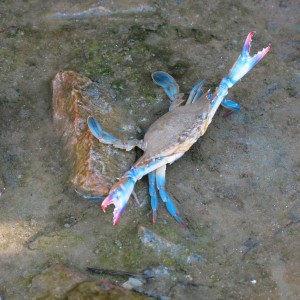 The persecution stopped when a law requiring police permission to hold public ceremonies was let go in the 1970s. Since then the religion has surged in popularity in Brazil. It is particularly practiced here in Salvador. For many followers it is not just a matter of religious belief but also of reclaiming the cultural and historical identity which slavery stripped them of.
The persecution stopped when a law requiring police permission to hold public ceremonies was let go in the 1970s. Since then the religion has surged in popularity in Brazil. It is particularly practiced here in Salvador. For many followers it is not just a matter of religious belief but also of reclaiming the cultural and historical identity which slavery stripped them of.
The reverence for nature in this religion is easy to understand here. Exploring Nature. This is impossible to avoid living here. The beach beckons at every minute. There is pretty much always some form of human life on the beach too. Except maybe on a Sunday morning, at 7:30am, when the calm sky unexpectedly gives way to sheets of driving rain. But typically there are a few people out in the water, pulling or riding a small wooden boat, stationary in a spot catching crabs, digging 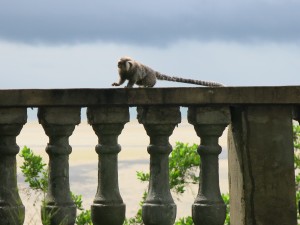 for mussels or other shellfish, or a couple of men holding fishing rods submerged. The ocean is of course alive much more than we can even see. But here you get a sense of the magnitude of it all. Small crabs, tiny!, with one disproportionate pincer. When you take the time to slow down, and walk, and look, you see and learn so much. At low tide, the ocean floor exposes these little perfectly formed balls of sand that blanket the beach. By the millions, billions? Then pausing to look closer, you see the ball being ejected by a crab.
for mussels or other shellfish, or a couple of men holding fishing rods submerged. The ocean is of course alive much more than we can even see. But here you get a sense of the magnitude of it all. Small crabs, tiny!, with one disproportionate pincer. When you take the time to slow down, and walk, and look, you see and learn so much. At low tide, the ocean floor exposes these little perfectly formed balls of sand that blanket the beach. By the millions, billions? Then pausing to look closer, you see the ball being ejected by a crab.
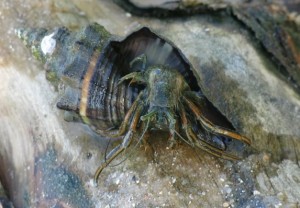 Welcome to the Video Corner! This short video, watch HERE, shows the thousands, millions?, of crabs underfoot with every step one takes. Then there are the hermit crabs which live in every single shell. Seriously. Housing is scarce. During low tide, where there are pools of shallow water, you can reach in and pick out as many shells as you desire. Each of them inhabited. If you stop for a moment to look, the entire ocean floor is moving. The shells are walking. This brief video shows them walking! Watch it HERE. And a remarkable 20-second close-up of a large hermit crab emerging from its shell. Watch it HERE. Scores of other videos to share: the storms, monkeys, dancers, new choreography…
Welcome to the Video Corner! This short video, watch HERE, shows the thousands, millions?, of crabs underfoot with every step one takes. Then there are the hermit crabs which live in every single shell. Seriously. Housing is scarce. During low tide, where there are pools of shallow water, you can reach in and pick out as many shells as you desire. Each of them inhabited. If you stop for a moment to look, the entire ocean floor is moving. The shells are walking. This brief video shows them walking! Watch it HERE. And a remarkable 20-second close-up of a large hermit crab emerging from its shell. Watch it HERE. Scores of other videos to share: the storms, monkeys, dancers, new choreography…
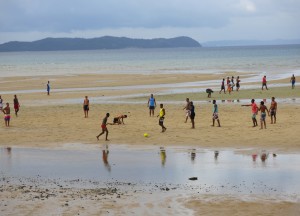 The fútebol (jogo de futebol) games are omnipresent. Even the rain does not deter the players. Or a quickly-vanishing sandbar. The boys, or men, pull branches from the mangroves for goalposts. I will be working in the studio and the shouts and exhortations from these games will call me outside to take photos and videos of their skilled athleticism. Is futebol a Brazilian stereotype? Certainly not all Brazilians love futebol, but the level of interest and proficiency is for the most part high. With crafty footwork even a clever boy can hold his own among a group of men. With a volleyball net, the players use only their feet!
The fútebol (jogo de futebol) games are omnipresent. Even the rain does not deter the players. Or a quickly-vanishing sandbar. The boys, or men, pull branches from the mangroves for goalposts. I will be working in the studio and the shouts and exhortations from these games will call me outside to take photos and videos of their skilled athleticism. Is futebol a Brazilian stereotype? Certainly not all Brazilians love futebol, but the level of interest and proficiency is for the most part high. With crafty footwork even a clever boy can hold his own among a group of men. With a volleyball net, the players use only their feet!
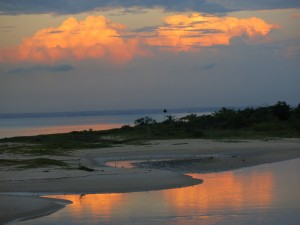 The sky is a constant draw. To stare at, frame, capture. How to share the countless photos I’ve taken of the sky alone? The same view always different. The sandbar I have been shooting the most is always visible, just to the right of the studio. How much the scenery changes. The composition of the clouds, the burning sunrises, the purplish pink and orange sunsets, the hourly play of light and shade, the multi-colored coral, the driftwood, the abundant wildlife: spider monkeys, peacocks, horses, dogs, turtles, birds, geckos, snails…these elements, the sheer beauty and the infinite variation, compulsively interest the artist without pause.
The sky is a constant draw. To stare at, frame, capture. How to share the countless photos I’ve taken of the sky alone? The same view always different. The sandbar I have been shooting the most is always visible, just to the right of the studio. How much the scenery changes. The composition of the clouds, the burning sunrises, the purplish pink and orange sunsets, the hourly play of light and shade, the multi-colored coral, the driftwood, the abundant wildlife: spider monkeys, peacocks, horses, dogs, turtles, birds, geckos, snails…these elements, the sheer beauty and the infinite variation, compulsively interest the artist without pause.
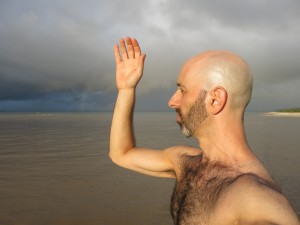 A few days ago the light literally pulled me from the studio. It was 4:30pm and I’d already been out at various times during the day. But there was something about this light. I grabbed the camera and headed to the pier. Standing on it, I took a shot. Enlarge the photo and you will notice the arco-íris (rainbow) to the left of my forearm. I had not seen it yet. Then I noticed. It quickly intensified in definition and color. Lo and behold, an entire arc of a rainbow. This close-up is not photo-shopped! The colors this rich. And all 180 degrees visible, from out in the Bay to the land here. Amazing!
A few days ago the light literally pulled me from the studio. It was 4:30pm and I’d already been out at various times during the day. But there was something about this light. I grabbed the camera and headed to the pier. Standing on it, I took a shot. Enlarge the photo and you will notice the arco-íris (rainbow) to the left of my forearm. I had not seen it yet. Then I noticed. It quickly intensified in definition and color. Lo and behold, an entire arc of a rainbow. This close-up is not photo-shopped! The colors this rich. And all 180 degrees visible, from out in the Bay to the land here. Amazing!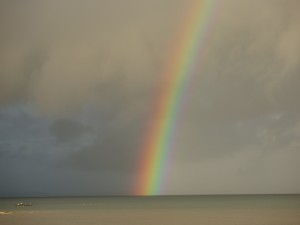
Creating so much here. I am spending a lot of time filming on the beach and in the town. Everyday is either a different shoot, or the continuation of a previous project. Is there a connection between studying the crabs and this crab-like position I find myself making?
I taught a few master classes this past week. One to a courtyard full of students and the second at the studio of the Balé Folclórico to the professional company. This was a thrill. 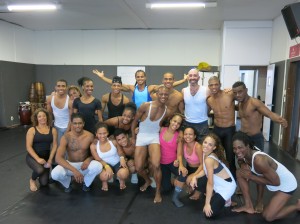 The class was challenging for them, as my classes tend to be, irregardless of level. I realize that the patterning and changes of directions and weight are atypical and not emphasized in most training. These are specific exercises that dancers are not wired to do unless studying in this technique. They were great to teach, very enthusiastic, and I will work with them again next week. Friday evening we went to attended the performance at the company’s own theater (Theatro Miguel Santana), a cozy space with not much width or depth, but still enough space for eighteen dancers plus musicians and singers.
The class was challenging for them, as my classes tend to be, irregardless of level. I realize that the patterning and changes of directions and weight are atypical and not emphasized in most training. These are specific exercises that dancers are not wired to do unless studying in this technique. They were great to teach, very enthusiastic, and I will work with them again next week. Friday evening we went to attended the performance at the company’s own theater (Theatro Miguel Santana), a cozy space with not much width or depth, but still enough space for eighteen dancers plus musicians and singers. 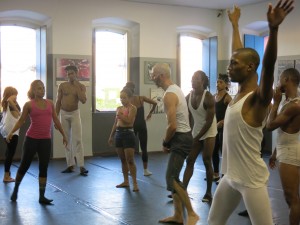 The show, performed nightly, mostly for tourists, is ranked the number one attraction on TripAdivsor.com for things to do in Bahia. And for good reason. The program-length dance traces the history of Brazilian dance, from candomblé to maculelê (the men use wooden sticks), to capoeira, to samba de roda. Jubilant and dynamic dance!
The show, performed nightly, mostly for tourists, is ranked the number one attraction on TripAdivsor.com for things to do in Bahia. And for good reason. The program-length dance traces the history of Brazilian dance, from candomblé to maculelê (the men use wooden sticks), to capoeira, to samba de roda. Jubilant and dynamic dance!
A terrific meeting with the director of the Escola de Dança of the Cultural Foundation of Bahia; it is the main dance center in Salvador. She would love for there to be an opportunity to work with the students. 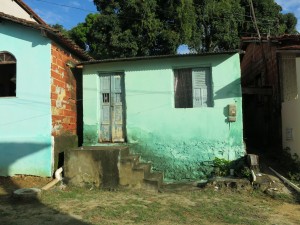 The school will let me use their studios. On the 17th I’ll teach a class to the university-level ones. I intend to incorporate some of these students into the different video and live projects. How is it that some of the projects are only just getting going at this point in the residency? Well, that is somewhat par for the course here in Bahia. As an American here on a Fulbright explained to met a few days ago, “I’ve been here since March and my project/research is only just getting started.” Things happen at a different pace, but they do happen. And what’s happening to me here?
The school will let me use their studios. On the 17th I’ll teach a class to the university-level ones. I intend to incorporate some of these students into the different video and live projects. How is it that some of the projects are only just getting going at this point in the residency? Well, that is somewhat par for the course here in Bahia. As an American here on a Fulbright explained to met a few days ago, “I’ve been here since March and my project/research is only just getting started.” Things happen at a different pace, but they do happen. And what’s happening to me here?
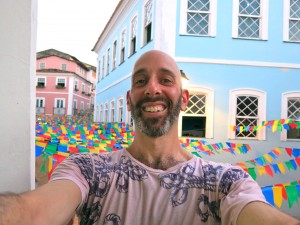 How am I affected by this daily wealth of beauty and inspiration? How is this reconciled with the reality of extreme inequality and poverty? What have I learned of my rigidity amid the relaxed tempo of Bahia? It is easy to exoticize the other, the different, the less-known. Knowing the people here, some intimately, helps counter this tendency. To see the grit within the glamour, the problems in paradise. A man grabbed the neck of one of the Fellows this past week in Salvador, breaking but not taking a chain from her grandmother.
How am I affected by this daily wealth of beauty and inspiration? How is this reconciled with the reality of extreme inequality and poverty? What have I learned of my rigidity amid the relaxed tempo of Bahia? It is easy to exoticize the other, the different, the less-known. Knowing the people here, some intimately, helps counter this tendency. To see the grit within the glamour, the problems in paradise. A man grabbed the neck of one of the Fellows this past week in Salvador, breaking but not taking a chain from her grandmother.
A privileged position to document all of this life, not only the natural world, but the people and places in Salvador. 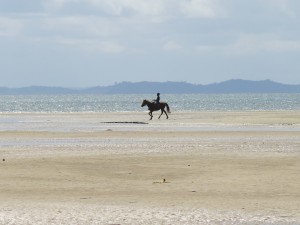 Always one sees a thin barefoot boy begging for coins near the elevator. People on the island who do not have potable water. One sees and hears all this, and more. And then what? What does one do not only in reflection, but action? As I consider these questions the rain continues, heavy and loud. Two games of futebol continue too, in the grey gloom, a few hundred feet away on the sand. Their shouts mix with the rain. The sun will come out again with force. Then the winds will pick up and more rain again. And then, inevitably, the burning sun.
Always one sees a thin barefoot boy begging for coins near the elevator. People on the island who do not have potable water. One sees and hears all this, and more. And then what? What does one do not only in reflection, but action? As I consider these questions the rain continues, heavy and loud. Two games of futebol continue too, in the grey gloom, a few hundred feet away on the sand. Their shouts mix with the rain. The sun will come out again with force. Then the winds will pick up and more rain again. And then, inevitably, the burning sun.
June 12, QUARTA-FEIRA (Wednesday) 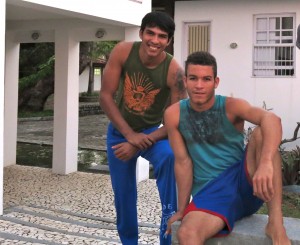 Day 6 of a stomach bug. It’s been going around among us. Unsure whether it’s from food or if it’s a virus traveling around Itaparica. Thankfully no symptoms besides a tender stomach and a little less energy than normal. But as long as I can keep going, I’m going! And there are multiple projects going on simultaneously. In the first week I had met Rafael Caravalho, a young filmmaker, photographer and dancer. We have collaborated on a video project shot on the pier here. For someone known for getting splinters, dancing on a pier barefoot might not seem the wisest idea. But do we really want to see
Day 6 of a stomach bug. It’s been going around among us. Unsure whether it’s from food or if it’s a virus traveling around Itaparica. Thankfully no symptoms besides a tender stomach and a little less energy than normal. But as long as I can keep going, I’m going! And there are multiple projects going on simultaneously. In the first week I had met Rafael Caravalho, a young filmmaker, photographer and dancer. We have collaborated on a video project shot on the pier here. For someone known for getting splinters, dancing on a pier barefoot might not seem the wisest idea. But do we really want to see 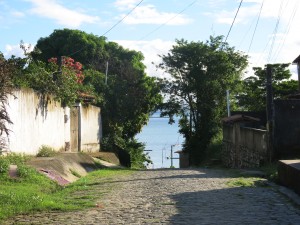 sneakers in the photo? Well, that is still a possibility. Especially after ripping off a piece of skin underneath my large left toe. The day before it was a piece of my right palm. (All of this is better than a piece of my heart! Although Brazil has had that for the last ten years.) Rafael has been eager to show a few possible shooting locations in Misericórdia, a small town on the island where he has lived since he was three. Yesterday we had plans to work, which can take different forms depending upon the light, the rain and the height of the sea.
sneakers in the photo? Well, that is still a possibility. Especially after ripping off a piece of skin underneath my large left toe. The day before it was a piece of my right palm. (All of this is better than a piece of my heart! Although Brazil has had that for the last ten years.) Rafael has been eager to show a few possible shooting locations in Misericórdia, a small town on the island where he has lived since he was three. Yesterday we had plans to work, which can take different forms depending upon the light, the rain and the height of the sea. 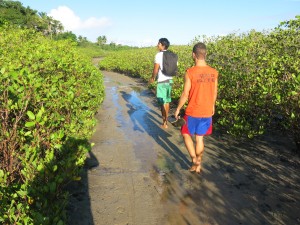 We have still been in a treacherous rainy period. It is light and dark, back and forth out of nowhere. Yesterday’s steely sky and morning rain did not make an outside shoot seem promising. But we looked in the direction of Misericórdia, about a 10 minute drive away, saw some blue and went for it. “Vamos!” Have not been on a motorcycle since the last time I was in Brazil. With a helmet, t-shirt, shorts and flip flops, I clasped the two handles behind me with force. As we crossed the hilly, muddy unpaved road outside Sacatar and onto the
We have still been in a treacherous rainy period. It is light and dark, back and forth out of nowhere. Yesterday’s steely sky and morning rain did not make an outside shoot seem promising. But we looked in the direction of Misericórdia, about a 10 minute drive away, saw some blue and went for it. “Vamos!” Have not been on a motorcycle since the last time I was in Brazil. With a helmet, t-shirt, shorts and flip flops, I clasped the two handles behind me with force. As we crossed the hilly, muddy unpaved road outside Sacatar and onto the  main road going 60km/hr I considered how inertia was not keeping me in place, it was sheer will. If I decided to loosen the grasp and lean back, it would all be over. Rain overtook us. We waited it out underneath a tree. And then spotted another arco-iris (rainbow). Apparently this time of year they are not so uncommon. Back on the road and down the extended winding road, cobbled together with stony bricks, to Misericórdia, literally Mercy. Population more or less 3500. This main road ends at the Bay, the other side of the island from Itaparica. It is
main road going 60km/hr I considered how inertia was not keeping me in place, it was sheer will. If I decided to loosen the grasp and lean back, it would all be over. Rain overtook us. We waited it out underneath a tree. And then spotted another arco-iris (rainbow). Apparently this time of year they are not so uncommon. Back on the road and down the extended winding road, cobbled together with stony bricks, to Misericórdia, literally Mercy. Population more or less 3500. This main road ends at the Bay, the other side of the island from Itaparica. It is 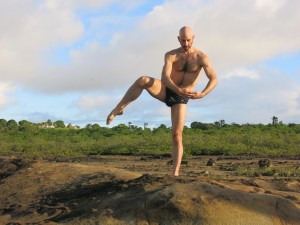 breathtaking to approach. We stopped by the house of Bruno, another part of our “team.” Bruno’s a student and aspiring dancer. We walked to the water, the guys barefoot, me in flip-flops, and into the mangroves (mangue). Bruno held the flip flops, Rafael the technology backpack, as we sank into the mud. Low tide. Crabs everywhere. This photo of me in yellow, enlarged, (Click!) shows me holding one! Different sizes, but all relatively small. Some tiny. Into a large basin of sand surrounded three hundred sixty degrees by mangroves. In it a set of large goalposts. No one around today. Continuing through a path we entered a volcanic type of rocky clearing. And inspiration flooded in. One large flat-ish boulder a stage on which to try out some new choreography. The late afternoon light was perfect. We got some excellent shots and videos. At one point Bruno joined in front of the lens. The light was exiting behind thickening clouds just as we had exhausted our ideas. Plus band-aids and Elastikon (tape) would not stay fixed to my feet! Then we noticed the huge black mass coming our way. Everything was packed up and we briskly moved toward the town. Rain. We ran. The path in the groves now filled to our knees with water. Tide coming in along with heavier rain. An empty structure near the water provided refuge. Wet already I thought why not stay out and dance on this pier, which is at least three times longer than the one I’ve been dancing on? Rafael, with umbrella, continued to shoot in the driving rain against the muted but still colorful sunset. A great day! So happy with this shot, below, by Rafael. We got it on the 11th try.
breathtaking to approach. We stopped by the house of Bruno, another part of our “team.” Bruno’s a student and aspiring dancer. We walked to the water, the guys barefoot, me in flip-flops, and into the mangroves (mangue). Bruno held the flip flops, Rafael the technology backpack, as we sank into the mud. Low tide. Crabs everywhere. This photo of me in yellow, enlarged, (Click!) shows me holding one! Different sizes, but all relatively small. Some tiny. Into a large basin of sand surrounded three hundred sixty degrees by mangroves. In it a set of large goalposts. No one around today. Continuing through a path we entered a volcanic type of rocky clearing. And inspiration flooded in. One large flat-ish boulder a stage on which to try out some new choreography. The late afternoon light was perfect. We got some excellent shots and videos. At one point Bruno joined in front of the lens. The light was exiting behind thickening clouds just as we had exhausted our ideas. Plus band-aids and Elastikon (tape) would not stay fixed to my feet! Then we noticed the huge black mass coming our way. Everything was packed up and we briskly moved toward the town. Rain. We ran. The path in the groves now filled to our knees with water. Tide coming in along with heavier rain. An empty structure near the water provided refuge. Wet already I thought why not stay out and dance on this pier, which is at least three times longer than the one I’ve been dancing on? Rafael, with umbrella, continued to shoot in the driving rain against the muted but still colorful sunset. A great day! So happy with this shot, below, by Rafael. We got it on the 11th try.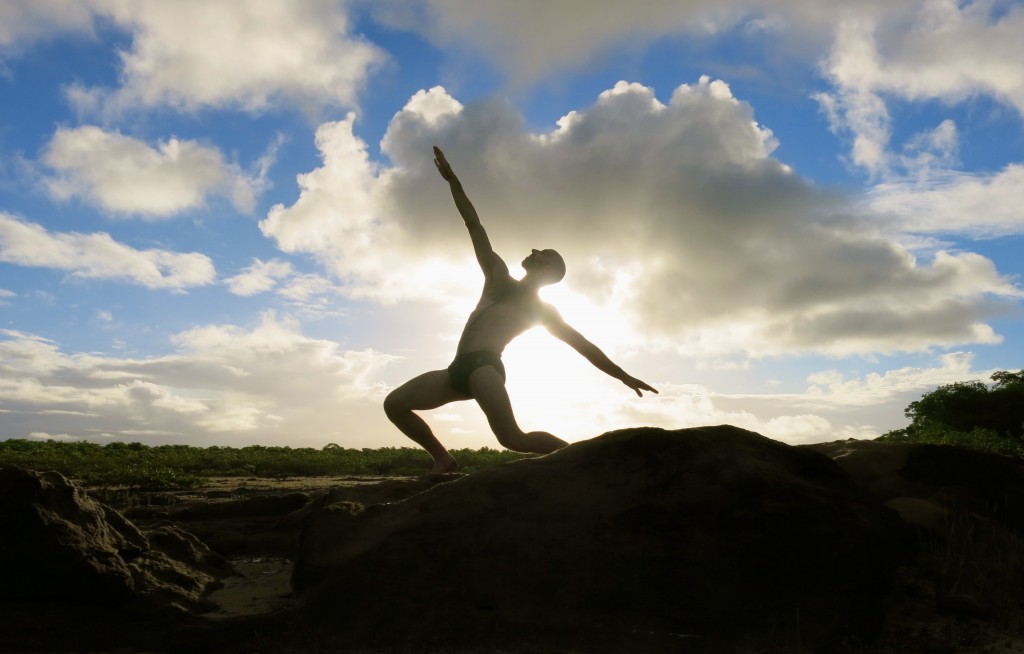
JUNE 15, SABADO (Saturday). So much happens everyday it is hard to document it all. The quantity of images and footage (people, places, nature) grows daily, along with the stories. For example, a few nights ago we were invited to this educational art center, Fundação Alafia. 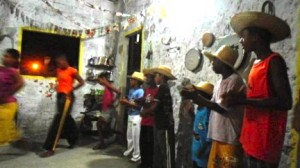 This incredible woman, Dedea, has been running this program for 25 years, daily from 5:30-7pm, taking children and adolescents off the streets and teaching them about visual art, theater and the musical and dance history of Bahian culture. She has had more than 400 students pass through her doors over the years. Her students, ranging in age from ten to late teens, most were around twelve, with one boy around five, performed for us: capoeira, maculelê, samba de roda. This is a very very poor area of the island and the center itself is both basic, a plastered room with a bare light bulb (as one sees everywhere), and also teeming with creative life.
This incredible woman, Dedea, has been running this program for 25 years, daily from 5:30-7pm, taking children and adolescents off the streets and teaching them about visual art, theater and the musical and dance history of Bahian culture. She has had more than 400 students pass through her doors over the years. Her students, ranging in age from ten to late teens, most were around twelve, with one boy around five, performed for us: capoeira, maculelê, samba de roda. This is a very very poor area of the island and the center itself is both basic, a plastered room with a bare light bulb (as one sees everywhere), and also teeming with creative life. 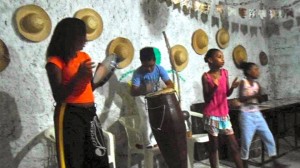 They recycle old CDs to make wall decorations and create bandeirolas (little flags) out of newspaper. The same as the colorful plastic ones that cover all the streets in Bahia now, in preparation for the upcoming Festa de Sao Joao. I did not have my camera with me unfortunately, but Veronny Odili, songwriter and singer from Nigeria, snapped these. In the mock-combative maculelê the dancers hold two sticks which they strike against the floor, and each other’s sticks. Rhythmic and dynamic, with similarities to capoeira.
They recycle old CDs to make wall decorations and create bandeirolas (little flags) out of newspaper. The same as the colorful plastic ones that cover all the streets in Bahia now, in preparation for the upcoming Festa de Sao Joao. I did not have my camera with me unfortunately, but Veronny Odili, songwriter and singer from Nigeria, snapped these. In the mock-combative maculelê the dancers hold two sticks which they strike against the floor, and each other’s sticks. Rhythmic and dynamic, with similarities to capoeira. 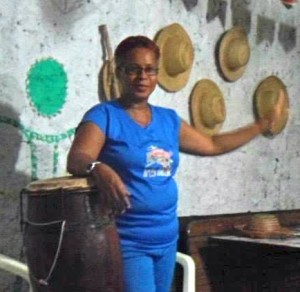 Here the students perform the samba de roda, defined by the gathering of participants in a circle (the roda). It is traditionally performed only by women, though not here, each taking her turn in the center of the ring surrounded by others dancing in the circle while clapping and singing. The choreography was set, with individual improvised solos and duet (girls and boys together, two by two). Samba is lightning-fast feet, legs and hips. I will return to teach these handsome, smart, happy and creative students. At one point during the samba a ten year-old boy, with a smile that could illuminate Salvador with its wattage, pulled me from the chair to join him. Veronny said the reaction was one of disbelief when I started to match his fast footwork.
Here the students perform the samba de roda, defined by the gathering of participants in a circle (the roda). It is traditionally performed only by women, though not here, each taking her turn in the center of the ring surrounded by others dancing in the circle while clapping and singing. The choreography was set, with individual improvised solos and duet (girls and boys together, two by two). Samba is lightning-fast feet, legs and hips. I will return to teach these handsome, smart, happy and creative students. At one point during the samba a ten year-old boy, with a smile that could illuminate Salvador with its wattage, pulled me from the chair to join him. Veronny said the reaction was one of disbelief when I started to match his fast footwork. 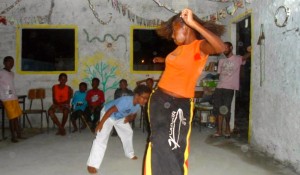 He had no idea that I could dance! At the end of the session Dedea had two large bowls of popcorn (pipoca). I left feeling that in the U.S., and other first world countries, we have so much, but so little. So empty is our culture. We have things. But no connection to a shared culture. And here, with so little, they have so much. To witness the pride and joy of these children, part of a continuous rich legacy, who easily move from tambourine to the berimbau to the drums, who know all the steps and the songs. Who have a profound delight in having this creative outlet and an implicit respect for each other and for their tradition. To watch this interplay between the young girls and boys, their maturity and proficiency in performance, their unabashed individual expression. It was another vivid understanding of the irrespressibly joyous and proud spirit of Bahia.
He had no idea that I could dance! At the end of the session Dedea had two large bowls of popcorn (pipoca). I left feeling that in the U.S., and other first world countries, we have so much, but so little. So empty is our culture. We have things. But no connection to a shared culture. And here, with so little, they have so much. To witness the pride and joy of these children, part of a continuous rich legacy, who easily move from tambourine to the berimbau to the drums, who know all the steps and the songs. Who have a profound delight in having this creative outlet and an implicit respect for each other and for their tradition. To watch this interplay between the young girls and boys, their maturity and proficiency in performance, their unabashed individual expression. It was another vivid understanding of the irrespressibly joyous and proud spirit of Bahia.
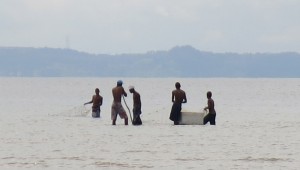 Yesterday, at 11:15am, needing to still shower, shave, dress, pack for the day in Salvador and eat lunch (in 45 minutes), I was pulled to the sea. Nerize Portela, the Brazilian artist here (all images and names in this journal are used with consent!), was in the shallow water taking photographs herself. We had an impromptu 15-minute shoot with awesome results. Those will be forthcoming! I love this close-up of these boys out with their nets.
Yesterday, at 11:15am, needing to still shower, shave, dress, pack for the day in Salvador and eat lunch (in 45 minutes), I was pulled to the sea. Nerize Portela, the Brazilian artist here (all images and names in this journal are used with consent!), was in the shallow water taking photographs herself. We had an impromptu 15-minute shoot with awesome results. Those will be forthcoming! I love this close-up of these boys out with their nets.
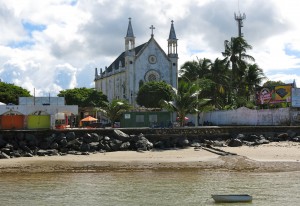 Tendai Huchu, writer from Zimbabwe who lives in Edinburgh and authored the acclaimed novel The Hairdresser from Harare, and I caught a car easily–one stops on the side of the road at a certain square and you tell the driver where you’re going. He’s either going to Bom Despacho, where the “ferry-boat” leaves, or Mar Grande, where you want to go. A proper taxi will cost between $20-$30 but in this shared fashion the cost is $3R ($1.50), even if you’re the only one to get in. A funny story about this, which I’ll get to. I don’t want to get
Tendai Huchu, writer from Zimbabwe who lives in Edinburgh and authored the acclaimed novel The Hairdresser from Harare, and I caught a car easily–one stops on the side of the road at a certain square and you tell the driver where you’re going. He’s either going to Bom Despacho, where the “ferry-boat” leaves, or Mar Grande, where you want to go. A proper taxi will cost between $20-$30 but in this shared fashion the cost is $3R ($1.50), even if you’re the only one to get in. A funny story about this, which I’ll get to. I don’t want to get 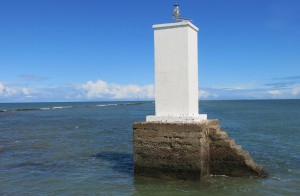 ahead of the day. We stopped for two other young men, students, a full car. The trip’s about 15 minutes. We made the 1:00 lancha, getting us to Salvador at 1:45. This is the church in Mar Grande, taken from the lancha. It was low tide and the barrier reefs which encircle Itaparica were fully exposed. At certain times in each month, when the level is at or below 0.3 meters, the lancha is cancelled (an hour before and after this time). Yesterday the water was at 0.6 meters at 1:20pm, the
ahead of the day. We stopped for two other young men, students, a full car. The trip’s about 15 minutes. We made the 1:00 lancha, getting us to Salvador at 1:45. This is the church in Mar Grande, taken from the lancha. It was low tide and the barrier reefs which encircle Itaparica were fully exposed. At certain times in each month, when the level is at or below 0.3 meters, the lancha is cancelled (an hour before and after this time). Yesterday the water was at 0.6 meters at 1:20pm, the 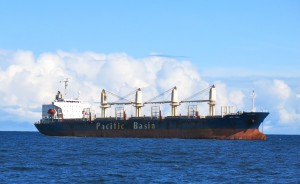 height of the low tide. Still, the boat scraped across these as we moved slowly out into the open sea. Tendai and I had referred to the tide schedule to see that the lancha would be going. These reefs are important. The name Itaparica, coming from the indigenous Tupi people, means “fence made of rocks.” The Tupi moved from the Amazon region to the south and the coast around 3000 years ago! The Tupi people inhabited almost all of Brazil’s coast when the Portuguese first arrived. In
height of the low tide. Still, the boat scraped across these as we moved slowly out into the open sea. Tendai and I had referred to the tide schedule to see that the lancha would be going. These reefs are important. The name Itaparica, coming from the indigenous Tupi people, means “fence made of rocks.” The Tupi moved from the Amazon region to the south and the coast around 3000 years ago! The Tupi people inhabited almost all of Brazil’s coast when the Portuguese first arrived. In 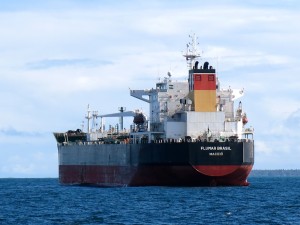 1500, their population was estimated at one million, nearly the same as the population of Portugal at the time. From the 16th century on the Tupi, like other natives, were assimilated, enslaved, or annihilated by the Portuguese settlers, nearly leading to their total extinction, with the exception of a few isolated communities. The remnants of these tribes are today confined to Indian reservations or acculturated to some degree into the dominant society. Business as usual for the imperialists. The container ships were especially striking yesterday against the blue water and
1500, their population was estimated at one million, nearly the same as the population of Portugal at the time. From the 16th century on the Tupi, like other natives, were assimilated, enslaved, or annihilated by the Portuguese settlers, nearly leading to their total extinction, with the exception of a few isolated communities. The remnants of these tribes are today confined to Indian reservations or acculturated to some degree into the dominant society. Business as usual for the imperialists. The container ships were especially striking yesterday against the blue water and 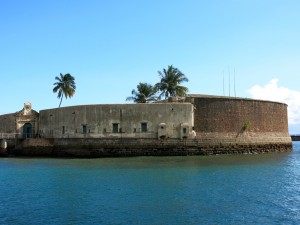 sky. I kept standing up like a tourist, negotiating the heavy swaying of the boat, and ensuring the camera wouldn’t go overboard–although I almost did at one point–by securing the strap around my neck. It’s wonderful to be out in the open sea traveling through these boats from the island to the big city. The pleasure of this commute! The Forte de Nossa Senhora do Pópulo e São Marcelo, known as Forte Do Mar, is a circular fort that was built a bit from the shoreline to avoid any invasion of the port. In the 1670s it had nine cannons. How exactly was this built in the water? The marvel of engineering!
sky. I kept standing up like a tourist, negotiating the heavy swaying of the boat, and ensuring the camera wouldn’t go overboard–although I almost did at one point–by securing the strap around my neck. It’s wonderful to be out in the open sea traveling through these boats from the island to the big city. The pleasure of this commute! The Forte de Nossa Senhora do Pópulo e São Marcelo, known as Forte Do Mar, is a circular fort that was built a bit from the shoreline to avoid any invasion of the port. In the 1670s it had nine cannons. How exactly was this built in the water? The marvel of engineering!
 The São João Festival begins on the 24th of the month and for weeks the preparations have been coming. Now, this past week, the island and the City, and indeed towns and cities everywhere across Brazil, are beginning to celebrate. The bandeirolas are everywhere. Festa de São João, named so because it’s a celebration of the nativity of St. John the Baptist, is an annual Brazilian celebration historically related to European Midsummer that takes place in the beginning of the Brazilian winter. The festivities, less commonly known as Festa Junina (June
The São João Festival begins on the 24th of the month and for weeks the preparations have been coming. Now, this past week, the island and the City, and indeed towns and cities everywhere across Brazil, are beginning to celebrate. The bandeirolas are everywhere. Festa de São João, named so because it’s a celebration of the nativity of St. John the Baptist, is an annual Brazilian celebration historically related to European Midsummer that takes place in the beginning of the Brazilian winter. The festivities, less commonly known as Festa Junina (June 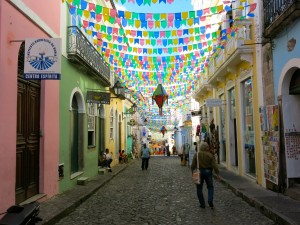 Festival), were introduced by the Portuguese during the colonial period. They are celebrated nationwide but nowhere as vibrantly as here in this part of Brazil. As the Northeast is largely dry this festival not only coincides with the end of the rainy season of most states but also provides the people with an opportunity to give thanks to Saint John for the rain. They also celebrate rural life and feature typical clothing, food, and dance, particularly the quadrilha, which is similar to square dancing. Indeed, I taught the Virginia Reel weeks ago to some students who said it was
Festival), were introduced by the Portuguese during the colonial period. They are celebrated nationwide but nowhere as vibrantly as here in this part of Brazil. As the Northeast is largely dry this festival not only coincides with the end of the rainy season of most states but also provides the people with an opportunity to give thanks to Saint John for the rain. They also celebrate rural life and feature typical clothing, food, and dance, particularly the quadrilha, which is similar to square dancing. Indeed, I taught the Virginia Reel weeks ago to some students who said it was  like the quadrilha. The roots of this dance go back to Scotland and England. São João also celebrates marital union. The quadrilha features couple formations around a mock wedding whose bride and groom are the central attraction of the dancing. The celebrations usually take place in an arraial, a huge tent made of raw material (with a thatched roof) that was reserved for special parties in old rural areas. Men dress up as farm boys with large straw hats and women wear pigtails, freckles, painted gap teeth and red-checkered dresses, all in a loving tribute
like the quadrilha. The roots of this dance go back to Scotland and England. São João also celebrates marital union. The quadrilha features couple formations around a mock wedding whose bride and groom are the central attraction of the dancing. The celebrations usually take place in an arraial, a huge tent made of raw material (with a thatched roof) that was reserved for special parties in old rural areas. Men dress up as farm boys with large straw hats and women wear pigtails, freckles, painted gap teeth and red-checkered dresses, all in a loving tribute 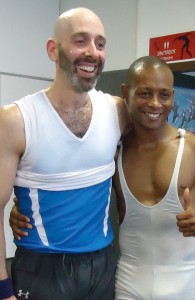 to the origins of Brazilian country music, and of themselves, some of whom are recent immigrants from the countryside to cities such as Olinda, Recife, Maceió and Salvador, and some of whom return to the rural areas during that season to visit family. Most people leave the city and travel to the interior. São João festivities are extremely popular in all urban areas and among all social classes. In the Northeast, they are as popular as Carnival. As during Carnival, the events include costumes, dancing, drinking, decorations and fireworks. These fireworks have been going off nightly for weeks here on the island. Like the original European Midsummer celebrations, during the multi-week June parties, bonfires are lit. Gilberto Gil will be performing during São João in Cachoeira for free and we’re going. Can’t wait to hear him sing live! I took Zebrinha’s company class at Balé Folclorico. Gramps held up great with the kids! Seriously, this was a Horton-based class with elements of ballet.
to the origins of Brazilian country music, and of themselves, some of whom are recent immigrants from the countryside to cities such as Olinda, Recife, Maceió and Salvador, and some of whom return to the rural areas during that season to visit family. Most people leave the city and travel to the interior. São João festivities are extremely popular in all urban areas and among all social classes. In the Northeast, they are as popular as Carnival. As during Carnival, the events include costumes, dancing, drinking, decorations and fireworks. These fireworks have been going off nightly for weeks here on the island. Like the original European Midsummer celebrations, during the multi-week June parties, bonfires are lit. Gilberto Gil will be performing during São João in Cachoeira for free and we’re going. Can’t wait to hear him sing live! I took Zebrinha’s company class at Balé Folclorico. Gramps held up great with the kids! Seriously, this was a Horton-based class with elements of ballet.  I was kicking my heels up for sure. This was a real rush, to enter a class where nothing is explained, no talking. You just go! After class Tendai (who came to meet me) and I watched some of Herança Sagrada (Sacred Heritage), the new work in development choreographed by Zebrinha about the Orixas that goes on tour internationally in the fall. Love this piece, my second time seeing it! This photo is of Reinaldo Pepe Santos, the assistant to the choreographer and one of the principal dancers. From there I went to the Escola de Dança to catch a
I was kicking my heels up for sure. This was a real rush, to enter a class where nothing is explained, no talking. You just go! After class Tendai (who came to meet me) and I watched some of Herança Sagrada (Sacred Heritage), the new work in development choreographed by Zebrinha about the Orixas that goes on tour internationally in the fall. Love this piece, my second time seeing it! This photo is of Reinaldo Pepe Santos, the assistant to the choreographer and one of the principal dancers. From there I went to the Escola de Dança to catch a  free presentation of the students. You can see the signs for the school if you blow up this photo of these musicians playing last night in the street. We left early to catch the 8pm lancha and made it just in the nick of time for the 7:30. Once back we waited on the corner for a ride. A small car stopped with someone in the front seat and three people in the back. No worries. The driver said to get in. I wedged the boy in front into the middle, his arm propped against the ceiling the entire ride. And somehow Tendai squeezed into the back with the three others. The seven of us weighted the car so that at each speed bump, and there are numerous on the main road, we could hear the bottom of the car scraping. Anything for a buck.
free presentation of the students. You can see the signs for the school if you blow up this photo of these musicians playing last night in the street. We left early to catch the 8pm lancha and made it just in the nick of time for the 7:30. Once back we waited on the corner for a ride. A small car stopped with someone in the front seat and three people in the back. No worries. The driver said to get in. I wedged the boy in front into the middle, his arm propped against the ceiling the entire ride. And somehow Tendai squeezed into the back with the three others. The seven of us weighted the car so that at each speed bump, and there are numerous on the main road, we could hear the bottom of the car scraping. Anything for a buck.
Next week I begin an ambitious project at the Escola de Dança, teaching daily morning professional-level classes and developing a site-specific video dance for potentially a large cast. I have not met the dancers yet I’ll be working with, and will use tomorrow’s class as an audition. In the afternoons I’ll spend time with the Balé Folclórico. A busy week. Especially as I’ll be leaving the island before breakfast everyday! Went grocery shopping for oatmeal and bread this weekend. I’ll need my carbs! And my emergency cashews! More to come! Enjoy! Saude!
DOMINGO, JUNE 30
Suddenly it is the last Sunday, the last full day. I leave Brazil tomorrow. The last two weeks a sprint. The happiest sprint. Each day an adventure with Bahia. So much has happened during this time: the protests which riveted the world and of which I joined at this historic moment; the São João festivities (and festive they were!) which lasted days (weeks really); dancing in the square and getting the town to join!; the Quadrilhas, the elaborately choreographed dances for scores of dancers of European origin (a highlight was being invited to be a judge for the quadrilha here in Itaparica! Then to see the tremendous dancing in Salvador the following night; the videos are incredible documents); filming in Salvador in the streets and on the island non-stop; editing four films; and performing here at the Institute last Friday night. To live and document at the same time, that is to be and comment simultaneously is a tall order when the days are dwindling and the activities increasing. I do not have the bounty of time to record all of this while still here in Brazil. These last hours are heavy with saudade. Indeed, I’ve been crying for days. Each hug goodbye. Goodbye to Salvador I had to say last Wednesday, and goodbye to the Balé Folclórico company. Thursday was editing from morning til morning. Friday the dancers came to the island and we rehearsed until the second the studio doors opened. There, on that dark wood floor, with a glowing pink sunset and the Bay behind us, we performed Celebração! (Celebration!), my newest dance. How proud and thankful I am for the dancers. How much I love them. How much I love all dancers. How much I miss working with them already. In time, I will sift through these hundreds of videos and edit, write the scores of stories and fill in the many gaps. For now let each picture conjure a bounty of words. And let me run to the tide that is leaving, and was high hours ago, and be with the water one more time.